Looking for a burst of creativity? Try quick sketchbook ideas like drawing your morning coffee, doing a blind contour self-portrait, or sketching your room in five minutes—no fancy gear needed. Capture the sky from your window, draw one object from four angles, fill a page with goofy mini faces, or slap together a tiny collage. You can even do a 60-second gesture drawing or doodle an illustrated quote. Fun and mistakes totally welcome—curiosity will take you even further.
Key Takeaways
- Fill a page with quick mini faces, trying different expressions, angles, and accessories for fast, playful practice.
- Combine two animals in a surreal creature mashup, blending textures and colors for unexpected and fun designs.
- Do a one-minute blind contour self-portrait, drawing your outline without looking at the paper to boost creativity.
- Illustrate a favorite daily quote with expressive lettering and colors, mixing words and art for quick inspiration.
- Make quick value studies using only black and white to explore dramatic light, shadow, and simplified forms.
Draw Your Morning Coffee or Tea
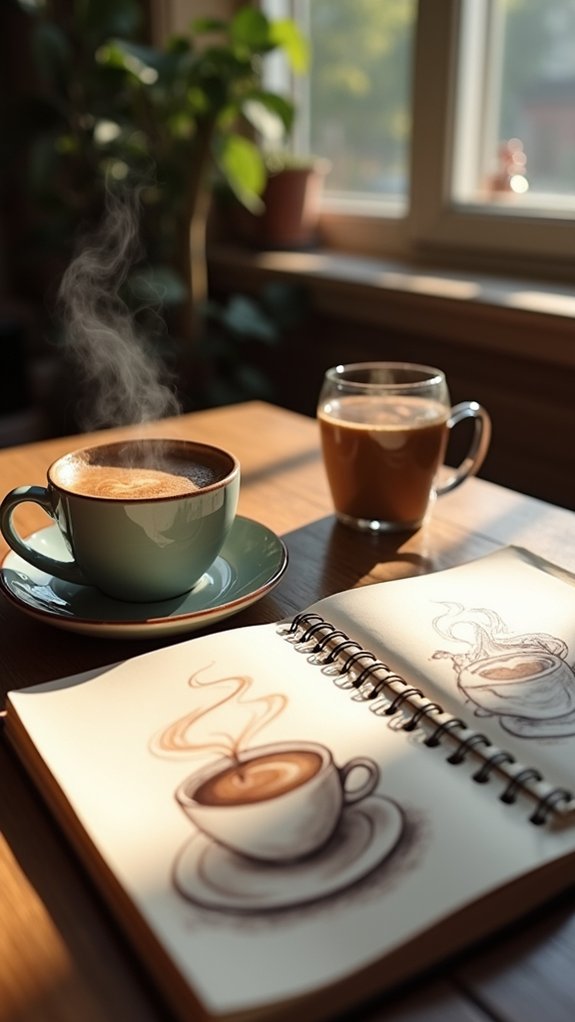
A steaming mug can be more inspiring than it looks, especially when it’s part of a quick sketching session. Instead of only drawing buildings, why not point your pencil at your morning coffee or tea?
Try capturing the steam swirling up like it’s dancing—loose, quick lines really show off the warmth. Change things up by drawing from the top, or get close to sketch the fascinating details in the drink’s surface.
Watercolors and colored pencils can help you mix up those rich brown coffee shades or the soft colors of tea. Don’t forget the tiny stuff, like reflections, the cup’s textures, even a crumpled tea bag.
Toss in your favorite book, or a cozy blanket, and tell your morning story visually!
Blind Contour Self-Portrait
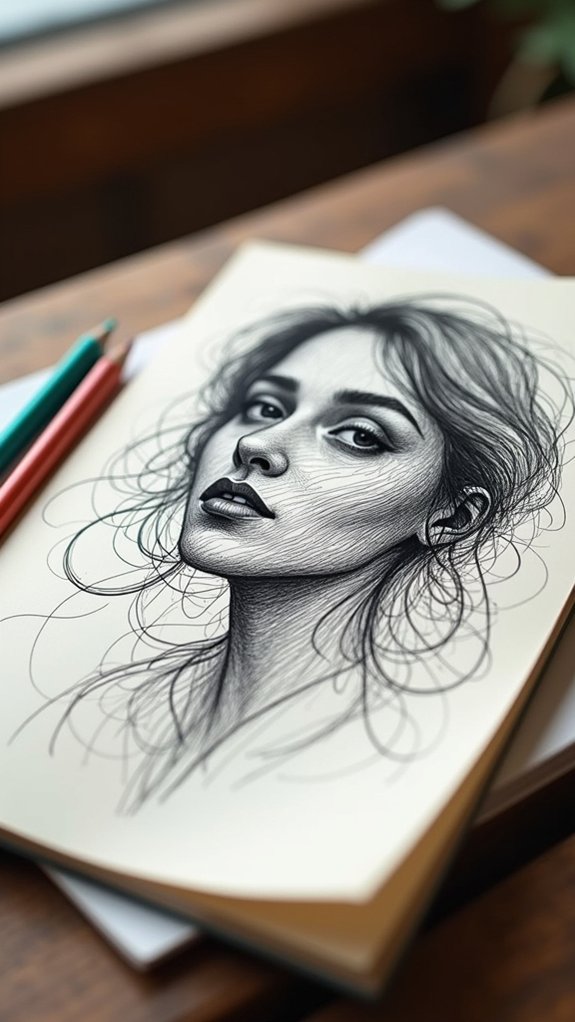
Even the bravest artists can feel a bit silly when trying a blind contour self-portrait. This wild sketching adventure asks you to draw your own face without once peeking at the paper. Instead, the focus shifts to tracing the outlines of your features with your eyes while your hand cruises along, completely unsupervised. It’s a shaky, hilarious, and super effective way to boost hand-eye coordination and start an artistic journey that’s all about embracing weirdness and letting go of perfection. Absurd lines and lopsided noses? Welcome! Using a pen or marker makes every mark permanent, so there’s no chance to erase. The magic is in the mess, and regular practice helps confidence soar. Here’s what to expect:
| Step | Feeling | Result |
|---|---|---|
| Don’t look down | Awkward, giggly | Wonky outlines |
| Outline features | Focused, nervous | Unusual proportions |
| No erasing | Brave, determined | Bold, unpredictable marks |
| Embrace flaws | Amused, surprised | Abstract self-portrait |
| Review result | Proud, amused | Unique artistic keepsake |
Map Out a Five-Minute Room Sketch
Most sketchbooks could use a little taste of daily life, and there’s nothing quite like a lightning-fast room sketch to make things interesting.
With a five-minute room sketch, the challenge is all about speed—no time for overthinking or erasing lines! Start by picking any room you know well, maybe your bedroom or the kitchen.
Quickly block in the basic layout and rough shapes for doors, windows, and big furniture. Don’t sweat the crooked lines; the point isn’t perfection, but capturing the essentials before the timer buzzes.
Want to get bonus points? Add quick labels like “couch zone” or “snack headquarters” to make your sketch extra clear.
Most importantly, keep it loose and fun—embracing chaos is part of this creative adventure!
Capture the Sky From Your Window
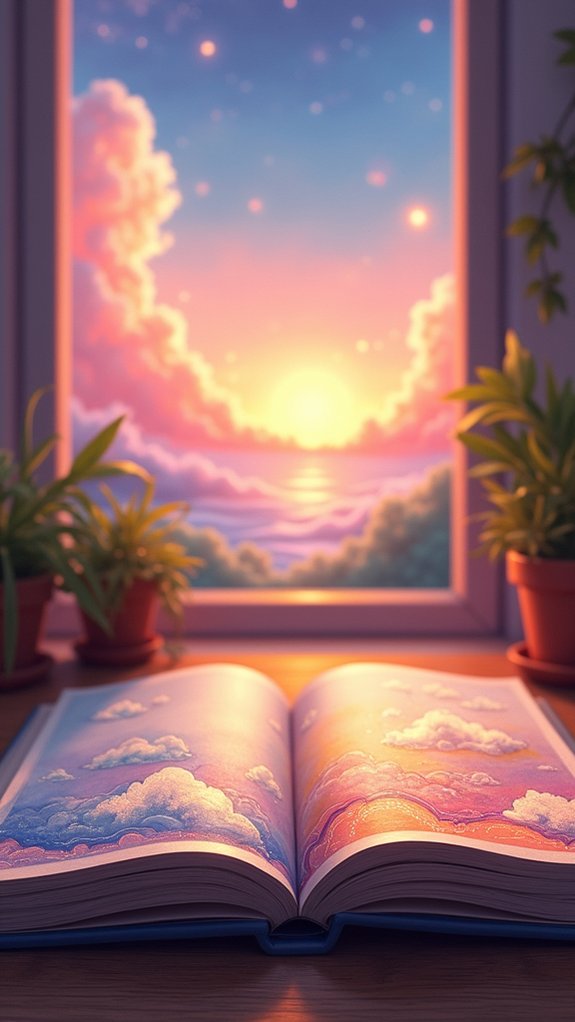
Skies have a way of putting on a show, right outside any window, and a sketchbook is the perfect front-row ticket. Every hour, the sky shifts—clouds twist into dragons or giant scoops of ice cream, while colors go from soft blues to wild, fiery oranges at sunset.
To capture the essence of these changes, quick sketches using colored pencils or watercolors work wonders. Don’t stress over getting every detail—try timing yourself for just five minutes, and see what stands out. Doodle rooftops, a line of trees, or even a curious bird flying by to add depth and personality.
Abstract lines and squiggles can speak louder than you’d think. Remember, when the sky keeps moving, your creativity can move just as fast.
One Object, Four Angles
After all that sky-watching, it’s time to flip the focus and zoom in on something right on the desk—a single object.
Drawing one object from four angles quickly turns any ordinary thing (think mug, key, or quirky rock) into a mini adventure. Observing it from different sides reveals hidden details, mysterious shadows, and shapes you might have missed before.
It’s all about training your brain—and your eyeballs!—to see things in new ways, fueling your sketchbook with surprise and excitement.
Try these challenges:
- Draw the same object from above, below, front, and side—each one’s a new puzzle!
- Change up your materials for each angle—maybe try pencil, ink, charcoal, then watercolor.
- Play with lighting: bright, moody, dramatic, or mysterious.
- Invent a different background for every sketch—let your imagination loose!
Non-Dominant Hand Quick Draw

Plenty of artists, even the pros, get sweaty palms when someone suggests drawing with the “wrong” hand. But non-dominant hand drawing is actually a superpower in disguise. When you switch hands, your brain has to work overtime—suddenly, every line is unexpected and kind of wild. This means zero pressure for perfection and a huge boost to your creative bravery. The results? Weird shapes, bumpy lines, and accidental masterpieces. It’s a playful way to shake off a creative block and loosen up your style. Plus, regular practice can even make both your hands better at drawing over time. If you’re looking for inspiration, check out this quick table:
| Challenge | Surprise Benefit |
|---|---|
| Wobbly lines | Fresh, unexpected designs |
| Awkward control | New creative directions |
| Creative block | Boosts observation and dexterity |
Speedy Fruit or Vegetable Study
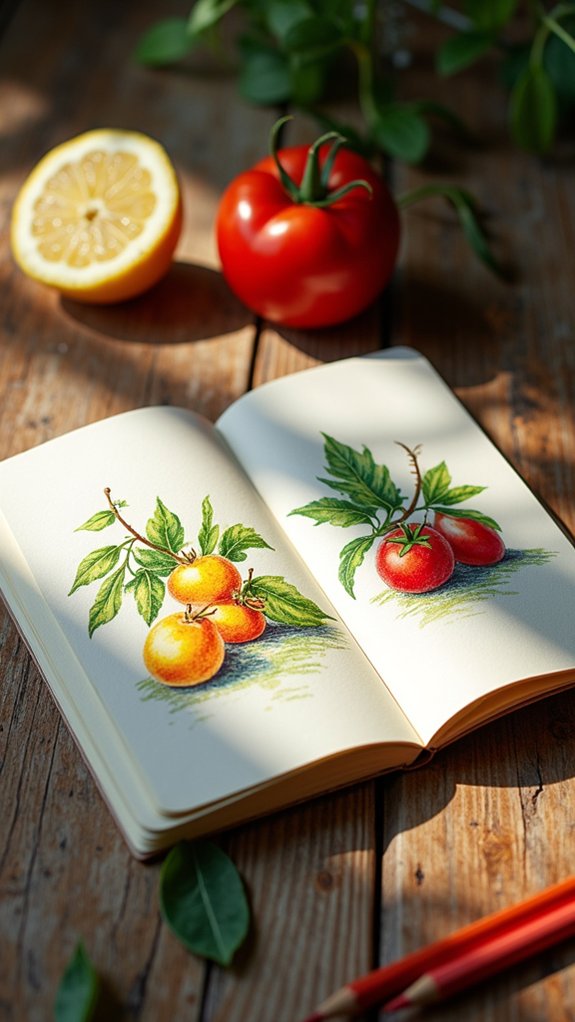
Speedy fruit or vegetable studies are a blast—just grab some fresh produce that looks totally different from each other, like a bumpy orange or a super shiny bell pepper.
The trick is to sketch really fast, catching the main shapes and splashes of color before your apple rolls away or your banana starts to pout.
Throw in some quick shadow with colored pencils or squiggly watercolor lines, and suddenly that carrot looks like it has attitude!
Choosing Fresh Produce Subjects
A pile of apples, a clump of grapes, or even a lone, slightly bumpy potato—fresh produce makes awesome sketchbook subjects for anyone craving a quick burst of creativity. Fresh produce isn’t just healthy; it’s also packed with surprise details that practically beg to be drawn.
There’s something magical about the quirky shape of a carrot, the weird shine of an eggplant, or the speckled surface of an orange. Suddenly, a trip to the fridge feels like a creative adventure!
Here are four reasons to pick fresh produce for your next speedy study:
- Every fruit and veggie has a wild texture—get ready for challenge!
- Weird shapes keep your sketches lively and unique.
- Mixing color is way more fun with real-world examples.
- Quick practice = instant progress!
Capturing Shape and Color
Grab a handful of colorful produce, set the kitchen timer, and suddenly the sketchbook transforms into an art battleground—can those wild banana curves or moody bell pepper shadows be captured before the buzzer sounds?
When it comes to capturing shape and color, the race is on. Artists pick fruits or vegetables with bold contours and punchy colors—think purple grapes, gnarly carrots, or a bumpy orange.
With just 10 to 15 minutes, there’s no time to fuss. Instead, quick lines and splashes of color get the job done, using vibrant watercolors or pencils. Some sketches turn realistic; others get wild and abstract. The goal is to catch the energy, not every tiny bruise.
Later, artists review the sketches, spotting growth in capturing shape and color, ready for next time.
Quick Shading Techniques
After those wild color bursts, it’s time to bring things down to earth—literally—with some speedy shading action. Quick shading techniques make sketching fruit or veggies fast, fun, and honestly, kind of magical.
Just grab a pencil or a stick of charcoal—no need to get fancy—think about where your light is coming from, and get those shadows down! Forget tiny details and keep it expressive. Let’s get those shapes popping:
- Start with simple shapes—just circles, ovals, or weird blobs—before diving into shading.
- Pick a light source and roll with it. Shadows need a plan!
- Experiment with hatching or cross-hatching. Wild scribbles can look so cool.
- Try gentle smudges with your finger or a tortillon for a soft, juicy look!
Fast, fun, and deliciously sketchable.
Surreal Creature Mashup
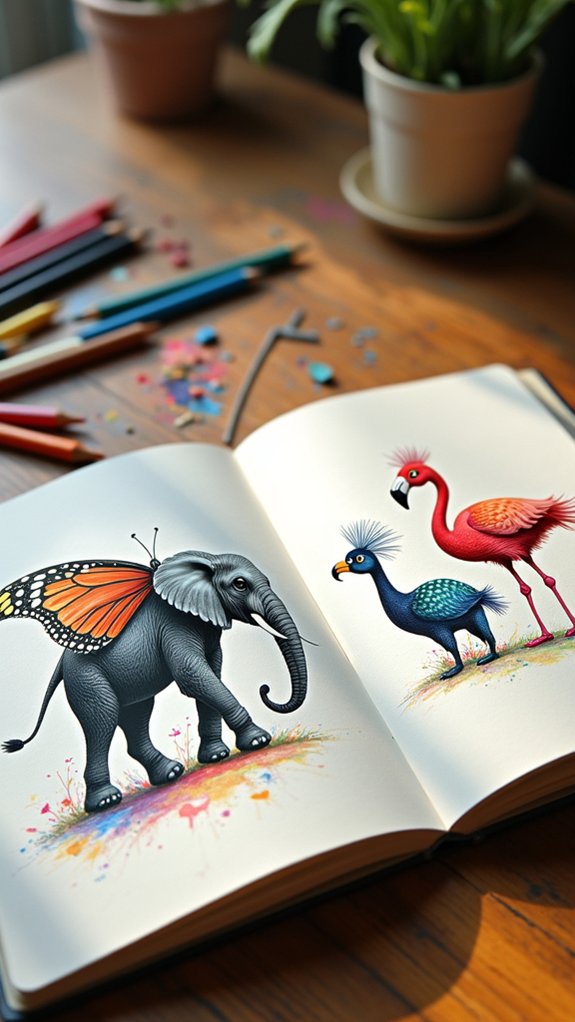
When imagination runs wild, sketching a surreal creature mashup can feel like bringing a dream to life—one with fins, fur, and maybe even antennae if the mood strikes. This playful art challenge starts by mixing two or more totally different animals, like a lion and a fish. Imagine a lion’s fierce mane with fishy scales and sharp fins—wild, right? Use simple shapes first, then merge the animal parts in fun and unexpected ways. Boost the fantasy by using bold colors and adding oversized eyes or weird textures that don’t exist in real life.
| Step | Playful Suggestions |
|---|---|
| Pick 2+ animals | Lion + Fish = Roaring Swimmer |
| Sketch simple shapes | Mix circles, ovals, triangles |
| Blend textures/colors | Furry gills, spotted tentacles |
| Set in wild locations | City? Space? Underwater cave? |
Surreal creature mashup, meet your sketchbook!
Favorite Shoes Memory Sketch
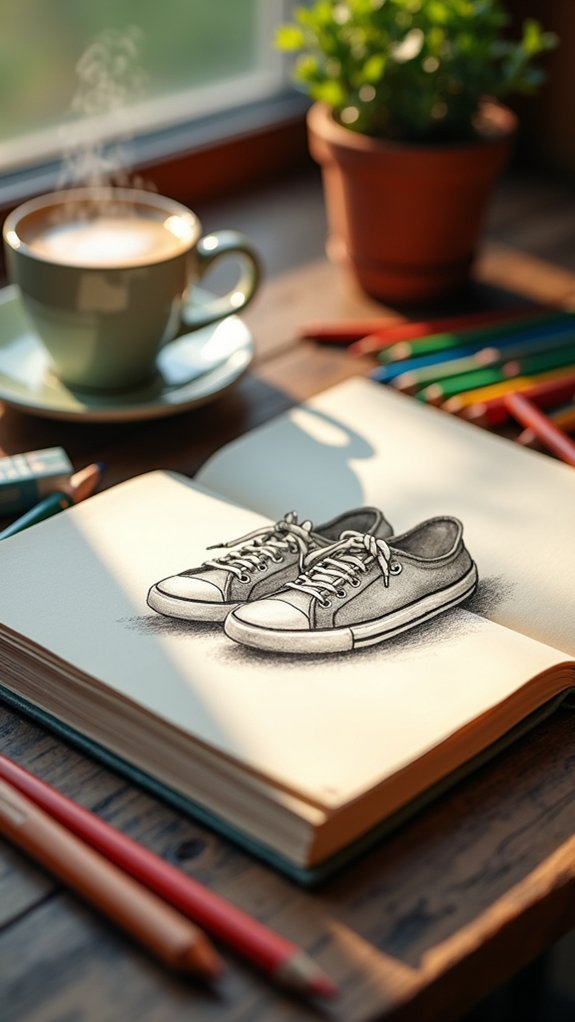
Capturing the look of your favorite shoes in a sketchbook isn’t just about drawing some laces and rubber soles—it’s about freezing a piece of your story on the page.
Each scuff or crease can remind you of a hilarious trip, a game-winning shot, or just that time you sprinted for the bus and actually made it.
Capturing Shoe Details
Sometimes, all it takes is a cool pair of shoes to spark a flood of memories and creative ideas. When exploring Sketchbook Ideas, focusing on shoe details can turn a simple drawing into an emotional masterpiece.
Shoes carry stories—they’ve run through puddles, danced at parties, maybe even survived gym class horrors! Bring those memories alive by zooming in on tiny features and adding splashes of color.
Try these ideas for shoe-inspired sketchbook magic:
- Notice scuffs, fraying shoelaces, or funky patterns—embrace every imperfection.
- Play with angles: top-down, sideways, even a dramatic toe close-up—let those shoes steal the spotlight.
- Highlight cool colors or stitched logos using colored pencils or watercolors.
- Sneak in tiny background hints—like grass stains or party confetti—to capture emotional moments.
Revisiting Nostalgic Stories
Although it might sound a little dramatic, favorite shoes can reveal some seriously powerful memories. Imagine sketching those old sneakers or boots that carried you through an epic summer or an embarrassing school dance. It’s not just about the shoes themselves, but the nostalgic stories they hold.
Pay attention to the little things—scuffed toes, faded laces, a weird sticker you never managed to peel off. Each mark is like a souvenir from a past adventure.
Try adding people or places that tie into your memory, like your best friend’s laughing face or the sticky floors of the roller rink. Use watercolors or colored pencils to bring these scenes to life.
It’s amazing how those sketches can turn simple shoes into true memory machines!
Continuous Line Animal
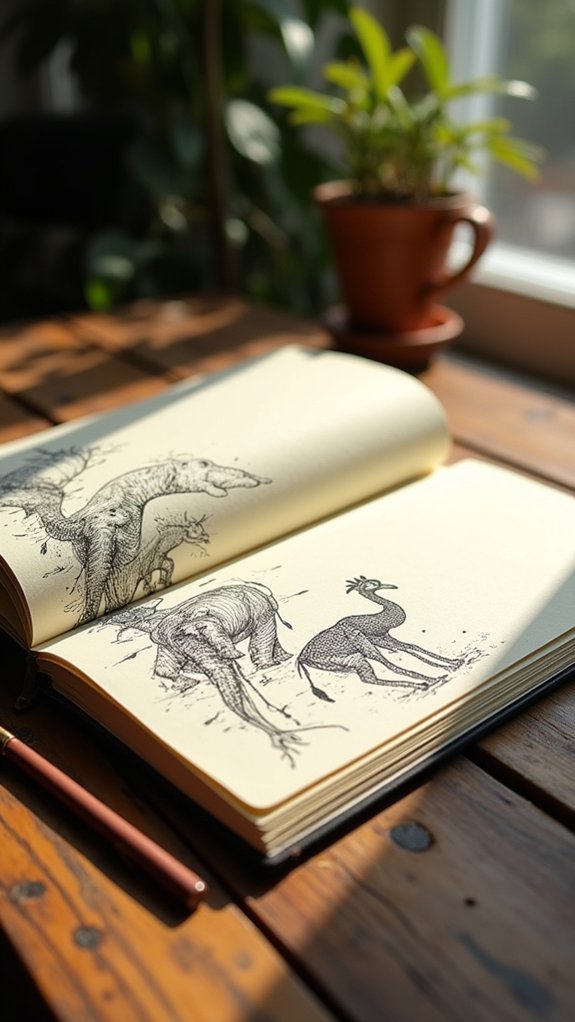
Once someone tries drawing an animal without ever lifting their pencil, things can get surprisingly wild—in a good way! Continuous line drawing pushes artists to embrace mistakes, giggle at weird shapes, and focus on the flow more than the tiny details.
It’s just you, your subject, and a single unbroken journey across the paper. Instead of worrying about perfection, artists look at the big shapes and let their hand move, sometimes resulting in silly-looking, but energetic animals. The magic is in the surprise—you never know exactly what creature will emerge.
- Feel the thrill of making wild, wobbly lines and realizing they look awesome.
- Laugh at the unexpected twists your drawing takes.
- Celebrate bold choices like thick, swoopy lines.
- Enjoy freedom from erasing or overthinking!
Quick Value Study: Two Tones Only
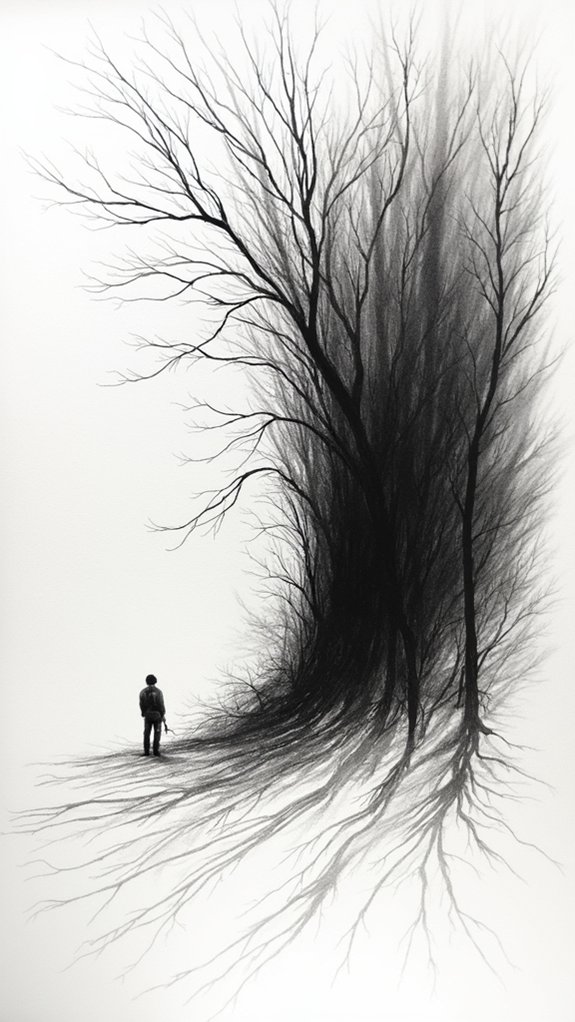
A quick value study with just two tones turns any sketch into a dramatic battle of light versus dark—no color needed!
By breaking a subject down this way, artists are pushed to make strong choices about which shapes are lit and which are in shadow, kind of like being the director of a mini spotlight show.
This not only turbocharges observation skills, but it also helps spot what really matters in the picture, making the whole composition way more exciting (and honestly, a little bit heroic).
Simplifying Light and Dark
Sometimes, staring at a blank page can feel like waiting for a plot twist that never comes, but diving into a quick two-tone value study is a total game-changer.
Using just black and white, artists get a front-row seat to the drama between light and shadow. With only two tones on the stage, every brush or pencil stroke counts, making the big shapes pop and giving even a simple sketch some serious depth.
Suddenly, figuring out what’s important in a drawing isn’t so mysterious or overwhelming. Check out these feels:
- The excitement of bold black and white shapes jumping off the page.
- That satisfying “aha” moment when the subject’s form comes to life.
- The thrill of making confident snap decisions about shadows.
- Feeling brave enough to tackle any sketch.
Impactful Composition Choices
When it comes to making a sketch really stand out, nothing beats the power of a bold composition, especially when you’re working with just two tones. Staring at a blank page can feel a bit like waiting for popcorn to pop—full of possibilities and suspense!
That’s where impactful composition choices come in. By limiting a quick value study to light and dark, artists get to play director, arranging the scene to grab attention. It’s like sculpting drama out of simplicity.
With just two tones, every line and shadow has to earn its place, which means the final image is instantly striking. This approach helps pinpoint the strongest arrangement of shapes, turning a plain sketchbook page into a tiny explosion of creativity and wow-factor.
Boosting Observation Skills
Bold compositions aren’t the only thing that make a sketchbook page pop—sharpening observation skills can turn even the simplest drawing into a showstopper. Quick value studies are the secret weapon here. By using only two tones, artists can forget about all the tiny details and just focus on where the light hits and where the shadows fall.
This not only helps drawings look more real, but it also makes you a decision-making wizard—no hiding behind fancy colors! Plus, you can whip these out in minutes, which makes practice impossible to skip (no excuses).
Here’s why quick value studies matter:
- They help artists truly “see” light and shadow.
- They build confidence in every mark made.
- They boost creative problem-solving game.
- They make sketchbook pages feel bold and alive!
Mark-Making Pattern Sampler
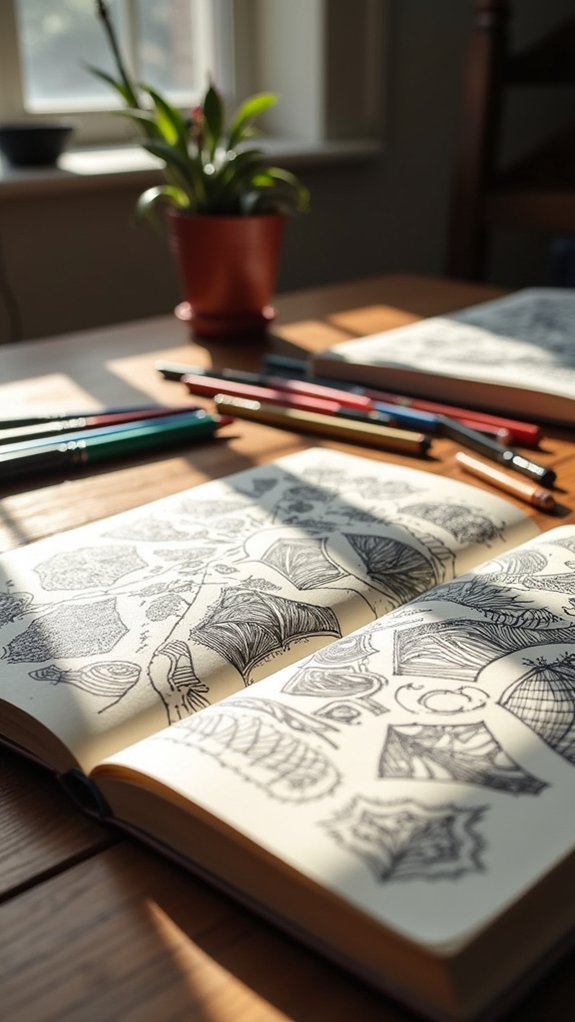
Although it might sound fancy, mark-making is really just a fun way to experiment with lines, shapes, and textures in a sketchbook. It’s like doodling’s cooler, smarter cousin! With mark-making, artists don’t just rely on pencils—they break out pens, brushes, sponges, and even things like sticks or combs. That’s when things get interesting. Repetitive patterns—think swirly lines, cross-hatching, or dots—can totally transform a boring page into something eye-catching. Try filling one sketchbook spread with every pattern and texture you can dream up. This sampler works as a handy cheat sheet for future masterpieces.
Here’s a quick sampler table to spark ideas:
| Tool | Pattern Name | Description |
|---|---|---|
| Pencil | Cross-hatching | Crisscrossed lines |
| Pen | Stippling | Lots of tiny dots |
| Sponge | Dabbing | Splotchy, random dots |
| Brush | Swirling | Wavy, looping lines |
Pocket-Sized Cityscape
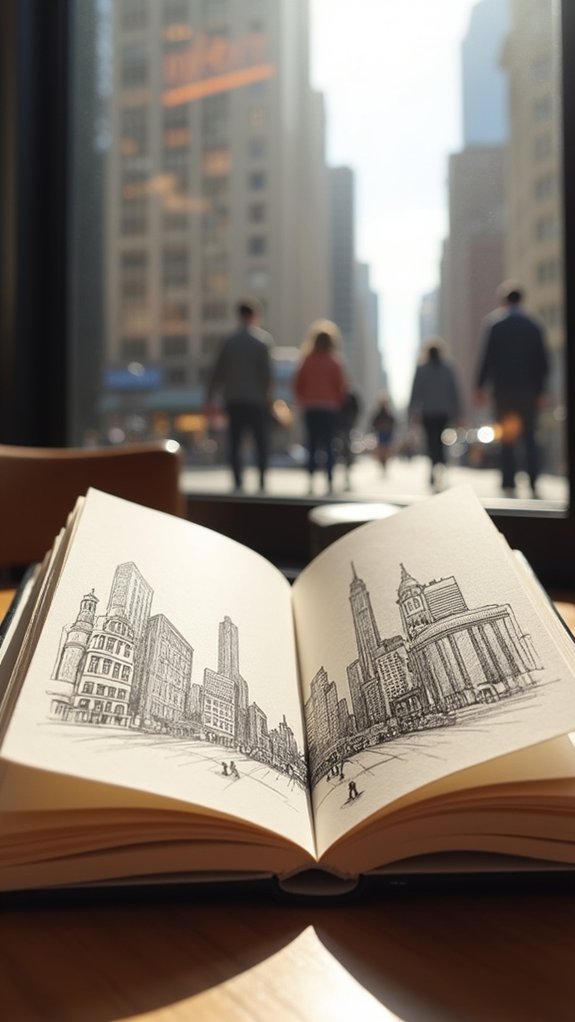
A pocket-sized cityscape sketchbook is a secret weapon for capturing urban details that might get lost in a big, noisy world.
Sketchers can play with miniature skylines, using sharp gesture lines and creative angles to squeeze skyscrapers, busy streets, and even surprise pigeons into the tiniest pages.
Add a splash of color or a quick outline—suddenly, even a bus stop or a crooked lamppost feels like it belongs in an epic movie.
Capturing Urban Details
City life is buzzing with energy, and a pocket-sized sketchbook makes the perfect sidekick for capturing those fast moments.
Urban sketches come to life when an artist zooms in on the details—think crowded street corners, café scenes, or even a funky mailbox. With every quick scribble or splash of color, the city’s personality jumps right off the page.
The trick is to get in, sketch fast, and collect little pieces of city magic before they disappear. Those quick notes and wild observations? They turn sketches into stories!
Here’s how small moments make a big impact:
- Notice quirky architectural features or graffiti hidden in your path.
- Feel the rhythm of passing people and busy sidewalks.
- Catch sunlight bouncing off windows in bold colors.
- Write down your emotions—surprise, excitement, joy—next to every urban sketch.
Miniature Skylines Techniques
Shrink the skyline and fit a whole city in your pocket—now that’s some real sketchbook magic! With miniature skylines, anyone can have major city vibes on the tiniest page.
Start by grabbing a small sketchbook—something handy for quick creativity sessions. When sketching, keep buildings simple: just shapes, silhouettes, and bold lines. No need to go overboard with details!
Try mixing up your view—maybe draw the city from way above, or right from the bustling streets. Toss in clouds, a few squiggly birds, or street scenes to give your urban scenery personality.
If you want your cityscape sketches to really pop, use watercolor washes or bold colored pens for instant depth. After all, who says an epic city can’t fit in your palm?
Nature Texture Rubbings
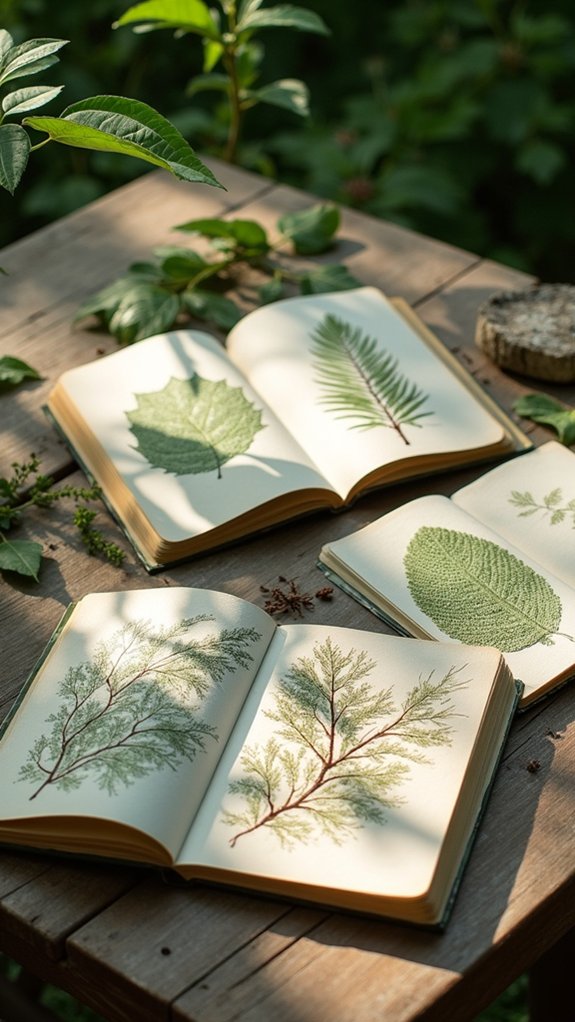
Few sketchbook activities are as unexpectedly cool as nature texture rubbings. Just find a gnarly old tree, a crunchy leaf, or a rock that looks a little too weird, slap some paper on it, and let a crayon or pencil dance across the page.
Suddenly, the wild details of nature pop out, making you feel like a texture detective on the scene! Using nature texture rubbings is a fast, hands-on way to study patterns you’d never spot otherwise. Plus, you can try colored pencils or pastels for even wilder effects.
The best part? You don’t need fancy supplies.
- Feel adventurous exploring new textures.
- Get excited about unexpected, one-of-a-kind artwork.
- Be amazed by nature’s hidden details.
- Share laughs with friends finding the weirdest spots.
Five-Minute Doodle Page
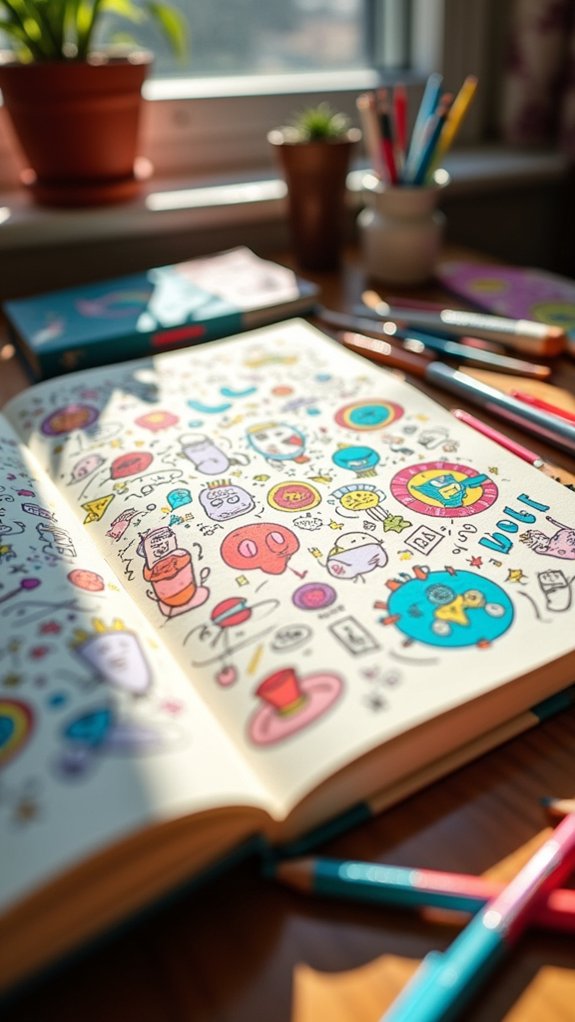
A five-minute doodle page shakes up any sketchbook routine with bursts of creativity that feel almost electric.
By letting pencil or pen race across the page for just a few minutes each day, artists can surprise themselves with what pops out when thinking time is super short—think of it as creativity doing sprints, not marathons.
There’s no time for second-guessing, just nonstop lines, shapes, and ideas sprinting out of nowhere, so every page ends up a wild mashup of inspiration and fun.
Spontaneous Daily Sketch Routine
Every single day can turn into a mini art adventure with a spontaneous five-minute sketch routine. Seriously, who knew five minutes could be so powerful? This quick, no-pressure creative burst can spark new doodles, lift moods, and even make you laugh at the weird shapes you end up drawing.
All it takes is a timer, some random prompts, and your choice of sketchbook weapon—maybe a pen, maybe a neon marker, maybe whatever you find on the floor. Here’s what keeps people coming back to this spontaneous habit:
- Bursts of silly, joyful energy with zero pressure.
- Watching your sketchbook fill up like a visual diary.
- Surprising yourself with weird, wonderful ideas.
- Noticing real improvement in style, one spontaneous doodle at a time.
Unleashing Creative Quick Bursts
When that five-minute sketch routine starts to feel like second nature, there’s something supercharged about filling an entire page with wild, speedy doodles.
Setting a timer for just five minutes makes quick and instinctive doodling feel like a mini creative race. Instead of sweating every line, artists can focus on simple shapes, funny faces, or even bizarre monsters. Everyday objects—or weird abstract swirls—pop up, thanks to playful prompts that jumpstart imagination and prevent anyone from freezing up.
Trying out markers, gel pens, or colored pencils, the page comes alive with color and surprise. Most important? Imperfection rules! These sketches aren’t masterpieces; they’re experiments, kind of like visual popcorn.
Who knows what will appear next? That’s the real magic of quick bursts!
Abstract Color Wash and Draw
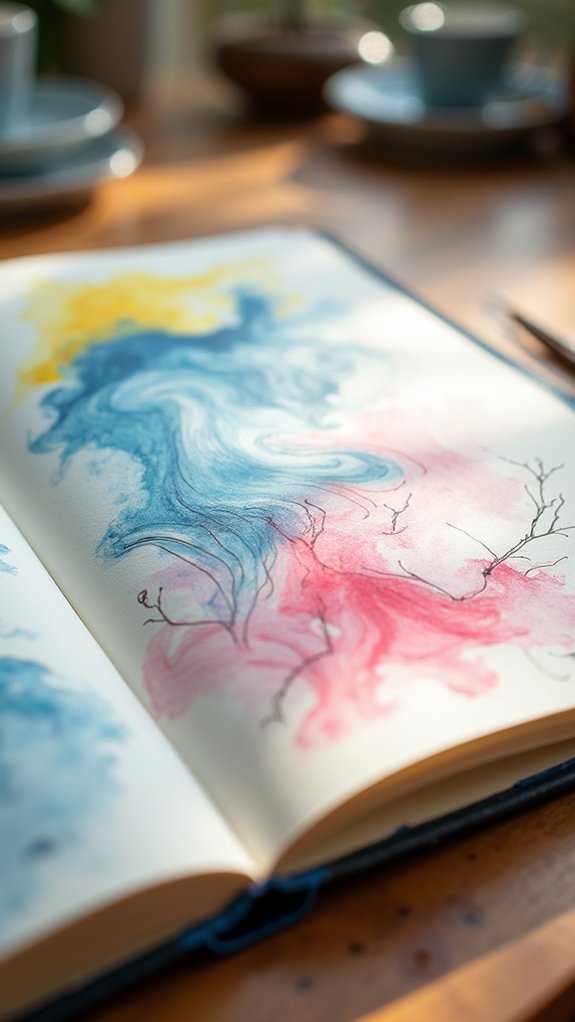
Dive right in—nothing says “let’s get creative fast” like splashing bold washes of watercolor or acrylic across a blank sketchbook page.
With wild colors flowing and blending, you’ve just built a playground for abstract shapes! Wait a bit for your wash to dry.
Then, pick up an ink pen, marker, or colored pencil and start drawing over the swirly background—maybe zig-zags, doodles, or shapes inspired by the colors themselves. There’s no right or wrong here.
- Feel the thrill of letting colors blend and react, almost as if your page is alive.
- Surprise yourself by drawing abstract shapes right on top, seeing what emerges.
- Play with light and dark shades for dramatic effect.
- Enjoy making quick, bold choices—no overthinking allowed!
Tiny Collage With Scraps
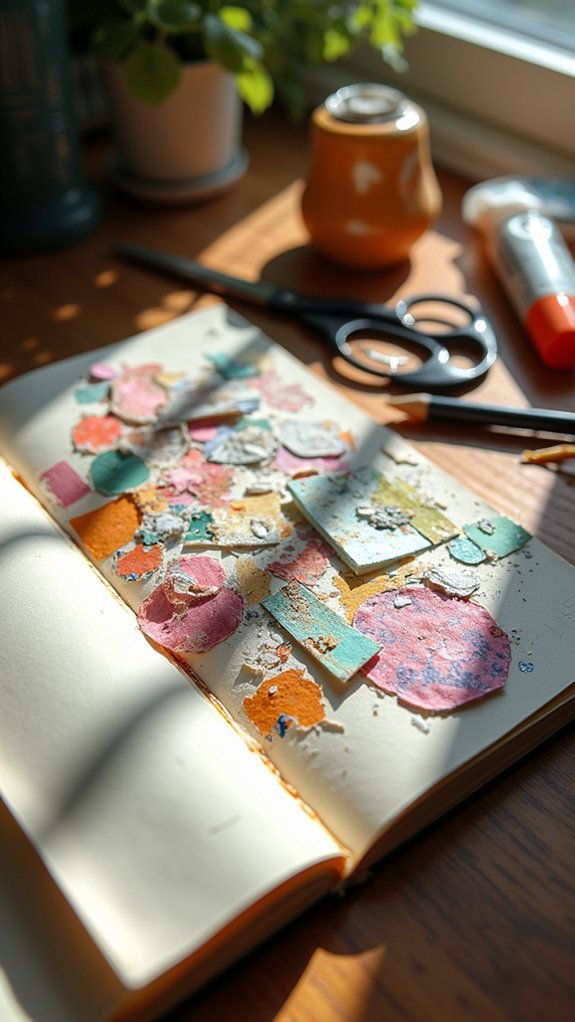
Scraps—those leftover bits of paper, trimmed edges of magazines, or even old fabric pieces—can become secret weapons for a burst of creativity.
Tiny collages use these materials in a way that’s super easy and seriously fun. Just grab your sketchbook, and start layering those colorful scraps into any shape or pattern you can dream up.
The best part? Because tiny collages are, well, tiny, you don’t need much space or time. It’s a perfect art break when you’re short on time but overflowing with ideas.
Mixing textures and colors can make each mini-masterpiece pop. Some people even create a storyline by adding a new collage every day.
Tiny collages might be small, but their creative power is huge!
One-Minute Gesture Figure
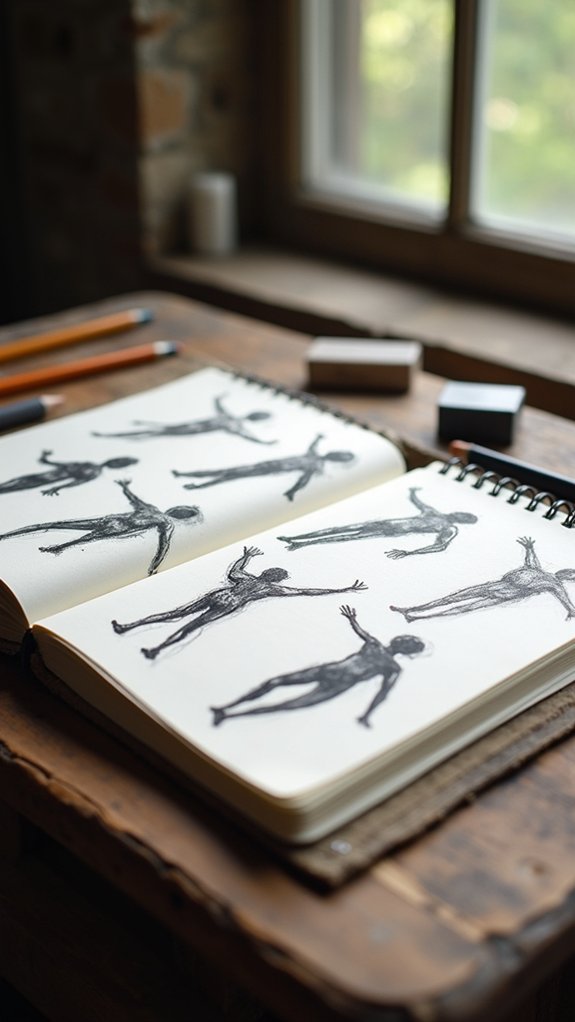
Snap into action with a one-minute gesture figure—possibly the quickest way to shake up creativity and sharpen drawing skills at the same time.
Imagine racing against the clock, grabbing your pencil, charcoal, or even a wild ink pen, and capturing a figure’s movement before the minute runs out! These quick sessions are about energy, not perfection.
Forget fine details; focus on the overall form, loose lines, and raw spontaneity. You’ll see how sketching this way builds confidence—and it’s pretty fun to see how wild your quick drawings can get with various mediums.
- Feel the rush—drawing with time pressure adds excitement and unpredictability.
- Embrace imperfection—celebrate scribbly lines and dynamic shapes.
- Challenge yourself—capture the essence of movement in record time.
- Mix it up—switch mediums and see which ones spark your imagination.
Fill-A-Page With Mini Faces
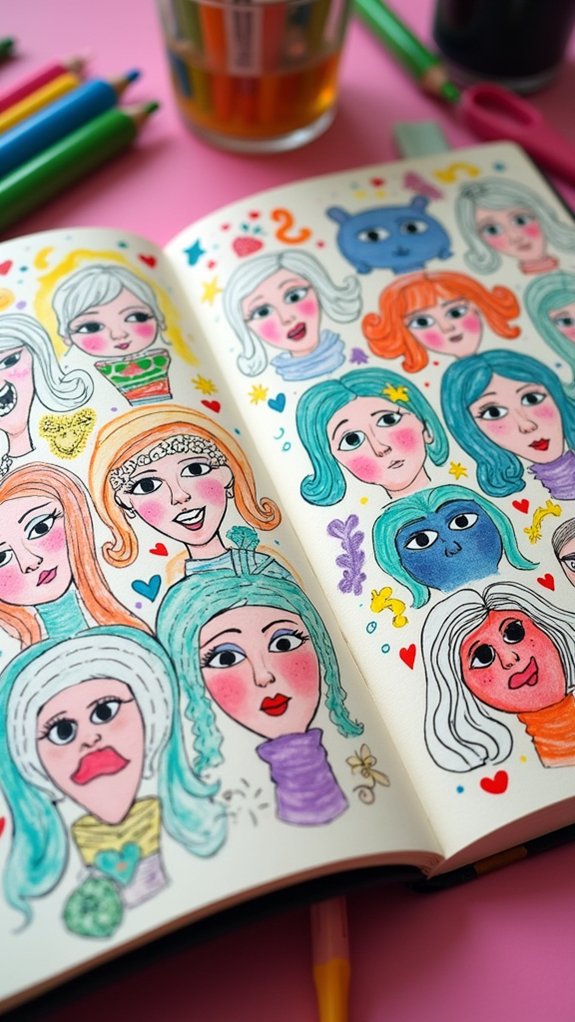
Sometimes a whole crowd of tiny faces is exactly what a sketchbook page needs to spark a creative mood. Drawing mini faces lets anyone practice facial features and wild expressions—fast!
There’s no rulebook here, so go wild with styles: silly cartoons, big grins, dramatic expressions, or even cool, realistic faces squeezed onto one page like a yearbook gone wild. Mix up angles too: try a profile, a three-quarter glance, or just a classic straight-on mug.
It’s surprising how much personality fits into a couple inches of space! Toss in wild hair, funky accessories, or completely over-the-top emotions. The low-pressure vibe actually helps you improve your skills while having fun.
Plus, it’s a perfect warm-up before bigger projects—or a tiny, joyful art break.
Illustrated Daily Quote
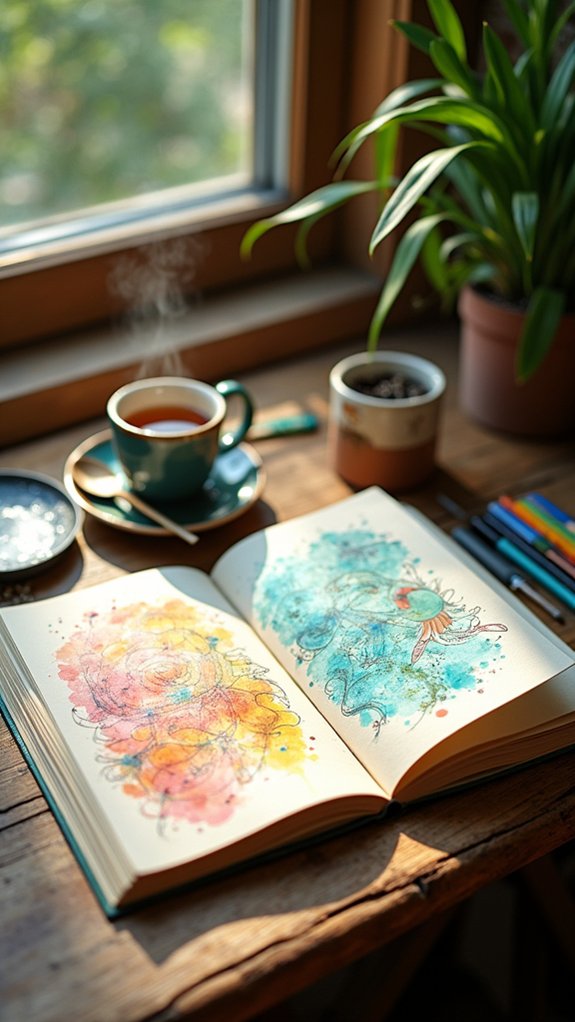
Quotes have a kind of magic—sometimes a few words can spark a whole day’s attitude or shift how someone sees the world.
Creating an illustrated daily quote in a sketchbook mixes cool art with words that matter, making each page pop with energy and meaning. Artists can play around with different styles of handwriting, splashy watercolors, or bold ink lines to spotlight the quote’s message.
Whether it’s a doodle-filled border or a wild new font, each illustrated daily quote can reflect whatever’s going on inside your head or heart.
Here’s what makes an illustrated daily quote super special:
- They’re daily bursts of inspiration and color.
- Drawing the words adds an extra layer of meaning.
- Every page turns into a little art installation.
- They spark real reflection—no filter needed.
Frequently Asked Questions
What Is the Easiest Thing to Sketch for Beginners?
For beginners, the easiest thing to sketch often involves simple shapes such as circles, squares, and triangles. Starting with these building blocks helps develop an understanding of proportions, structure, and composition before tackling more complex subjects.
How to Fill up a Sketchbook Quickly?
To fill up a sketchbook quickly, one can employ creative techniques such as daily timed sessions, speed drawing, blind contour exercises, and reworking previous sketches. Utilizing limited palettes and simple shapes also increases output and sparks ongoing inspiration.
What to Draw 100 Ideas?
When considering what to draw, one might generate a list of 100 ideas by focusing on everyday objects, human figures, imaginative creatures, and especially Nature Scenes, such as mountains, forests, rivers, or close-up studies of plants.
What Should I Draw First in My Sketchbook?
When considering what to draw first in a sketchbook, one might reflect on Inspiration Sources such as nearby everyday objects, favorite scenes, or personal emotions. Starting with familiar subjects can ease creative anxiety and promote observational accuracy.
Conclusion
A sketchbook doesn’t need to be perfect—it just needs to be yours. With these speedy, quirky ideas, anyone can fill a page, shake off creative cobwebs, and maybe even laugh at odd doodles along the way. The best part? There are no art police here, just your brain, your hand, and a pencil doing their own wild dance. So, why wait? Grab your sketchbook, scribble something quick, and watch your creativity come alive!

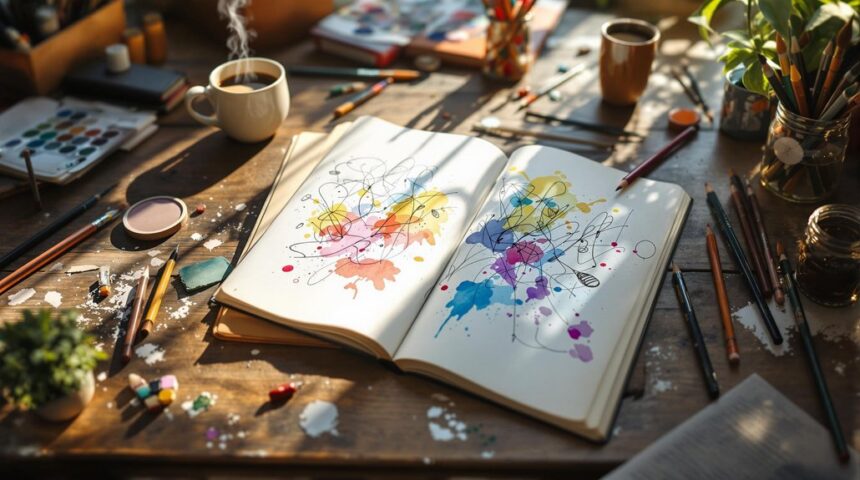
Leave a Reply